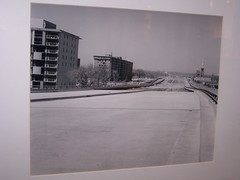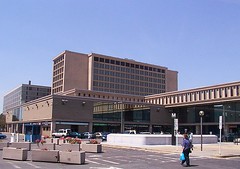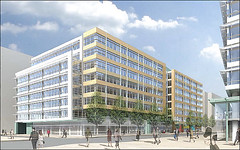Quotes of the day
 Caption: Another building in Southwest Washington is being demolished as part of the urban renewal program. This one is at Seventh street and Virginia Avenue SW;1957. Image: Washingtoniana Collection, Martin Luther King Library.
Caption: Another building in Southwest Washington is being demolished as part of the urban renewal program. This one is at Seventh street and Virginia Avenue SW;1957. Image: Washingtoniana Collection, Martin Luther King Library.Urban Renewal is still the dominant development paradigm shaping most municipal economic development programs, in DC and elsewhere.
1. From "Setting Standards in Syracuse's Sustainability," in the Syracuse Post-Standard:
"A city is like a person. You need to set up standards and you needto set up boundaries. Once you have boundaries and standards, then itbecomes easy to make your decisions. But if you keep changing yourstandards, someone else will come in and make your decisions for you,and that's what keeps happening in our city.".......
"I'll tell you what I want for Christmas. I want the PlanningCommission and the mayor and the county Legislature and the countyexecutive and all our decision makers to get on a plane and go toCharleston, S.C. I want them to walk around and see why that cityworks, and what can be done with wonderful planning, and howdevelopers - if you do it right - won't run away."
- Lonnie Chu, civic activist, Syracuse NY
2. From Norman Krumholz, "Equitable approaches to local economic development." Policy Studies Journal 27:1 (Spring 1999):
A constant, however, was support from the local media, who acted like cheerleaders, finding colorful and positive copy in pictures and stories of new construction, redevelopment, and the arrival of upper-income residents downtown.
Amid all of the new construction and the obvious regeneration of parts of the business district, nagging questions of equity, purpose, and effect remained.
3. Dana Hedgpeth, of the real estate development beat for the Business section of the Washington Post, writes about the redevelopment of Waterside Mall in the Southwest quadrant of Washington, DC. SW is one of the test beds for urban renewal in the United States. See "Waterfront Project to House D.C. Agencies," subtitled "SW Development Is Back on Track."
 SE-SW freeway under construction. Photo: DC Department of Transportation.
SE-SW freeway under construction. Photo: DC Department of Transportation.New Haven, Connecticut is the other, and do you really wonder why New Haven is still economically depressed, despite the wealth in Connecticut and the presence of Yale University in the city?
 Waterside Mall, Washington, DC. Photo: BeyondDC.
Waterside Mall, Washington, DC. Photo: BeyondDC.Waterside Mall is one of the artifacts of the urban renewal binge that completely reshaped that quadrant away from the building stock that typifies successful neighborhoods in the NW, NE, and SE quadrants of the city such as Capitol Hill. Likely the buildings that were extant before urban renewal would be each worth a minimum of $700,000 today.
 Shulman's Market on Union Street in SW. Circa 1941. Photo by Louise Rosskam, FSA-OWI Collection, Library of Congress.
Shulman's Market on Union Street in SW. Circa 1941. Photo by Louise Rosskam, FSA-OWI Collection, Library of Congress.Southwest DC has location, but it has little beauty or livability, and not enough population to support vibrant retail. One of the rostrums of modern city planning that traces its lineage to the Garden City movement (among the intellectual strands of planning that Jane Jacobs included when she referred to the "decentrists") is that cities were too dense.
As Sam Smith pointed out a couple months back in this piece, "Why smart growth isn't as smart as it thinks it is," one of the densest areas of DC is Capitol Hill, which is also one of the most attractive neighborhoods in the city. (Of course, the Garden City types were active in a time where cities were the centers of manufacturing with all the noise, waste, and smoke that came from it and experiencing massive in-migration with inadequate housing and sanitary conditions, so you do have to cut them some slack.)
Southwest fails from the standpoint of urban design and placemaking, because the principles of urban "renewal" weren't based on what made center cities thrive. And that's why Jane Jacobs wrote Death and Life of Great American Cities. But note, her first major piece on the subject, in the April 1958 issue of Fortune Magazine (which you can look at in the original at the Lauinger Library at Georgetown University) is titled "Downtowns are for People."
Jane Jacobs wrote in defense of people and places, not planning for cars and traffic.
So this sentence from yesterday's paper is absolutely delicious:
The neighborhood is cut off from the rest of the city by the freeway and has long been home to empty parking lots, nightclubs and older buildings.
Those were the same kinds of phrases used to justify urban renewal! And here, the problems of SW today were created by urban renewal (of which the interstate highway system is a form).
This is what I call blaming the building. The problem back then was disinvestment and the cure was investment, not necessary demolition and rebuilding.
Of course, today the solution is demolition and rebuilding, because the results of urban renewal were so dismal.
But I don't think, judging by this rendering, that the people "solving the problem" in today's Southwest quadrant really understand what the problem is, because it looks like they are merely repeating the mistakes from the past, just 50 years later!
 The redevelopment of Waterside Mall in Southwest D.C., shown in this architectural rendering, will include office, housing and retail space. (Image: Shalom Baranes Associates) .
The redevelopment of Waterside Mall in Southwest D.C., shown in this architectural rendering, will include office, housing and retail space. (Image: Shalom Baranes Associates) .Superblocks and superbuildings, as Jane Jacobs pointed out, are antithetical to active spaces. This is a problem in Southwest, this is the problem with the basic framework of modern city planning, which has been shaped by the superblock concept since the 1930s.
It's not just a problem in Southwest, it's a problem in Downtown DC, in Clarendon and Ballston (as I said on Monday), of course Crystal City and Rosslyn, in Bethesda and Silver Spring, and I hope it won't be a problem in Wheaton (not that I care that much), but see Rob Goodspeed's blog entry on it, "Can Wheaton Become the Next Silver Spring?"
Index Keywords: urban-design-placemaking



0 Comments:
Post a Comment
<< Home